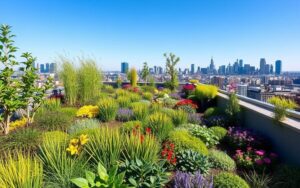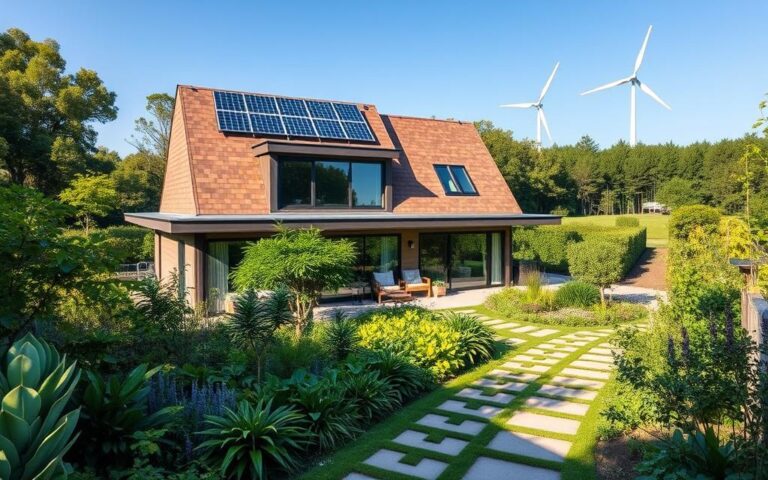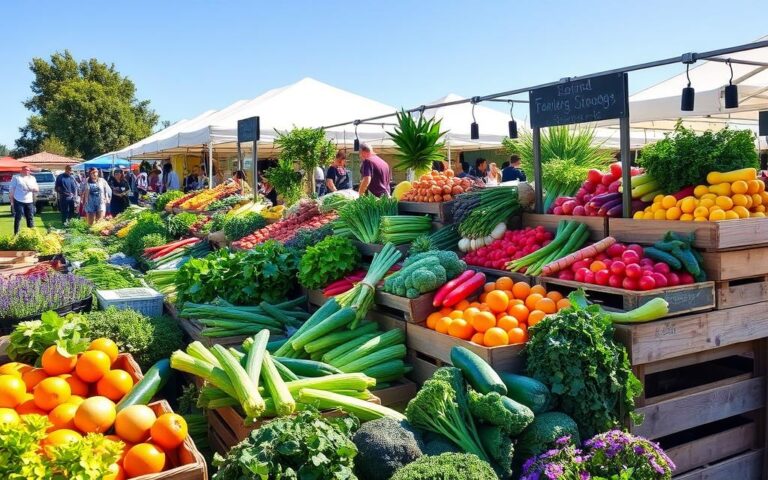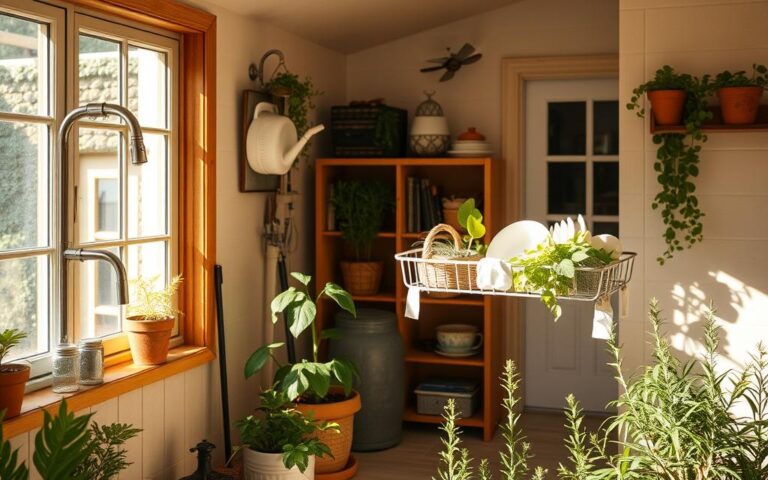In recent years, the green roof has become popular as a sustainable choice. It means putting plants on top of buildings. This helps make the air cleaner, reduces city heat, and manages stormwater better.
Adding a green roof also adds beauty to the property and can make it worth more. We will show you how to plan, design, and look after a green roof. This way, you’ll have a successful and eco-friendly roof.

Introduction to Green Roofs
Green roofs are a fresh way to mix nature with buildings. They are gardens on top of buildings, helping both the environment and making places look better. In American cities, green roofs are becoming a top choice for making urban areas greener.
There are extensive green roofs and intensive green roofs. Extensive ones have light plants, need less care, and don’t weigh much. They’re perfect where you can’t add much weight or work. Intensive roofs, however, can hold many kinds of plants and even places to hang out. They need stronger buildings and more care, fitting a wide variety of projects.
More and more people are choosing eco-friendly roofs. Knowing the difference between extensive and intensive roofs helps pick the right one for eco-smart buildings.
| Type of Green Roof | Vegetation Types | Maintenance Level | Weight Requirement |
|---|---|---|---|
| Extensive | Lightweight plants, sedums | Low | Lightweight |
| Intensive | Perennials, shrubs, small trees | High | Heavyweight |
Understanding the Benefits of Green Roofs
Green roofs are more than just pretty. One major green roof benefit is natural insulation. This cuts heating and cooling costs by a lot. In fact, buildings with green roofs can cut energy costs by more than 20%. This makes them a top choice for those wanting to save money and help the planet.
Green roofs are good for the environment too. They cool down cities, making them less hot. This means people use less air conditioning, saving energy.
They also help with stormwater. The plants and soil on green roofs hold rainwater. This stops flooding and lessens the strain on city drainage. This is especially important in cities with a lot of concrete.
Green roofs are good for nature in cities. They give homes to many plants and animals. They also reduce noise pollution. The layers of soil and plants block out city sounds.
Green roofs last a long time. They outlive regular roofs, making them a smart investment.
| Benefit | Description | Impact |
|---|---|---|
| Energy Efficiency | Natural insulation from vegetation | Reduces energy costs by 20% or more |
| Urban Heat Mitigation | Cools urban areas | Less demand for cooling costs |
| Stormwater Management | Reduces runoff with water retention | Improves drainage systems |
| Biodiversity Support | Provides habitat for wildlife | Enhances urban ecosystems |
| Noise Reduction | Acts as a sound buffer | Improves urban living quality |
| Prolonged Lifespan | Extends roof longevity | Enhances investment return |
Types of Green Roofs
Understanding the different types of green roofs is key to building and designing them well. Each type has its unique features and benefits. This means they meet various needs and looks.
Extensive, intensive, and hybrid systems are the main categories of green roofs.
- Extensive Green Roofs: These are known for their shallow soil, usually 2 to 6 inches deep. They support plants that need little water, like sedums. Because they’re light and easy to care for, they’re perfect for big city areas where weight is a concern. They increase green space without making installation too hard.
- Intensive Green Roofs: These have deeper soil, more than 6 inches, which lets them hold a wide variety of plants, such as grasses, bushes, and small trees. Even though they need more care, they’re worth it for their beauty and environmental benefits.
- Hybrid Green Roofs: These mix elements from both extensive and intensive roofs. This design offers more options. You can pick different plants and meet specific needs for structure and appearance.
Picking the right type of green roof requires thinking about design, like how much weight the building can hold and if there’s a need for watering. The choice affects how the green roof looks and helps the environment.
Planning Your Green Roof Project
Effective planning is key for a great green roof. First, check the current roof to see if it can hold a green roof. It’s also crucial to know the local building rules to ensure your project goes well.
Think about your budget when planning your green roof. You’ll need to account for materials, labor, and upkeep costs. Remember, a green roof not only looks good but also saves energy and supports city wildlife.
Working with experts in green building can really help. They offer design ideas that match your vision and follow the rules. This step lays a solid base, helping you reach your design and environmental goals.
Designing Your Green Roof
Creating a green roof requires balancing ecology with looks. Consider plants, water use, and drainage that meet eco-friendly goals.
Choosing the right plants is key. Go for local species since they’re tougher and need less care. Using a variety of plants helps local wildlife and builds a sustainable environment.
Plants thrive with good water systems. Think about using drip irrigation or collecting rainwater. This saves water and is better for the planet. Good drainage stops water build-up, protecting your roof and plants.
For an attractive green roof, mix plant textures and colors. Add sustainable walkways and seating for more beauty and use. These elements make green roofs visually pleasing and eco-friendly.
| Design Element | Considerations | Benefits |
|---|---|---|
| Plant Selection | Choose native species; consider height and spread | Supports biodiversity; requires less maintenance |
| Irrigation System | Implement rainwater harvesting; utilize drip irrigation | Conserves water; promotes healthy plant growth |
| Drainage Solutions | Use lightweight materials; ensure proper slope | Prevents water build-up; protects structure |
| Aesthetic Features | Incorporate hardscape elements; use diverse plants | Enhances visual appeal; provides functional spaces |
Combining these elements makes a green roof that looks great and helps the planet. Smart design leads to a lively, green space above.
How to Build a Green Roof
Building a green roof starts with a clear plan. First, check how strong your current roof is. You need to know if it can hold the extra weight of the green roof parts. This is a key step for a successful eco-friendly roof.
Then, put on a waterproof layer. This keeps the structure safe from water damage. Next, add a root barrier. This stops plant roots from breaking through the roof.
After that, add a drainage layer. It helps manage extra water, keeping plants healthy by preventing too much water. Then, put on the right substrate. The substrate is what plants will grow in. It should be light so it doesn’t make the roof too heavy.
At last, pick your plants and start planting. Go for plants that don’t need much water and do well in your area. Choosing the right plants makes your green roof look good and helps the environment.

| Step | Description |
|---|---|
| 1. Structural Assessment | Evaluate the roof’s load-bearing capacity. |
| 2. Waterproofing | Install a waterproof membrane to protect the roof. |
| 3. Root Barriers | Implement barriers against root penetration. |
| 4. Drainage Layer | Ensure proper water management and drainage. |
| 5. Substrate Application | Lay a lightweight growing medium for plants. |
| 6. Planting | Choose and plant drought-resistant vegetation. |
Essential Steps in Green Roof Construction
Constructing a green roof requires careful planning. This planning is crucial for a successful and sustainable green roof. It also helps in making buildings greener.
Choosing the right materials is the first step. It is important to select materials that are both light and tough. They should also be suitable for green roof setups, such as waterproof layers and drain systems.
Preparing the substrate is the next step. It’s about building layers for water drainage and protecting roots. A good substrate keeps moisture for plants but stops excess water.
Then, picking the right plants is key. Look for plants that match the local climate and your building. Native plants are best because they grow well locally. They make the roof look good, support nature, and need less care.
Safety is very important during construction. Workers need to know how to stay safe, especially up high. Following safety rules makes the work site safer for everyone.
Finally, you must follow local building laws. Understand what permits you need before starting. This helps you avoid legal problems later.
| Step | Description | Importance |
|---|---|---|
| Material Sourcing | Select high-quality, durable materials designed for green roofs. | Ensures system longevity and effectiveness. |
| Substrate Preparation | Create layers for drainage and root protection. | Promotes healthy plant growth and moisture retention. |
| Vegetation Selection | Choose native plants suitable for the environment. | Supports local ecosystems and reduces maintenance needs. |
| Safety Protocols | Implement safety measures for construction workers. | Prevents accidents and ensures compliance with safety standards. |
| Regulatory Compliance | Understand and acquire necessary permits and approvals. | Avoids legal issues and ensures adherence to local regulations. |
Eco-Friendly Roof Installation Practices
Choosing eco-friendly roof installation practices helps the planet and roof life. Using sustainable materials makes roofs last longer and helps the environment. When we use things like recycled content and renewable resources, we support better roofing choices.
Using gentle installation methods is key to protecting nature. Experts use special techniques to limit waste and save energy. This is different from DIY projects that can waste resources.
Energy-saving roofs are important for keeping buildings green. They help reflect heat and keep warmth inside, which cuts down on energy use. This is great for anyone wanting to lower their power bills and be eco-friendly.
| Practice | Description | Benefits |
|---|---|---|
| Use of Recycled Materials | Incorporating materials like reclaimed wood or metal. | Reduces waste and conserves natural resources. |
| Low-Impact Installation | Techniques that minimize soil disturbance. | Protects local wildlife and ecosystems. |
| Professional Installation | Engaging trained experts in roofing. | Ensures high-quality work and reduces errors. |
| Energy-Efficient Materials | Using materials that reflect sunlight. | Lower energy bills and improved temperature control. |
Making smart choices in roof installation leads to eco-friendly results. Homeowners making these choices help the planet. They also improve their home’s value and effectiveness.
Maintenance Tips for Your Green Roof
Keeping your green roof healthy requires routine care. Good maintenance helps plants grow and makes eco-friendly roofs more sustainable. Here’s how to care for your green roof:
- Regular Watering: Watch the moisture levels, based on your area’s weather. Water more in hot, dry spells.
- Weeding: Spot and remove unwelcome plants that could block your chosen greenery.
- Pest Control: Look out for pests and use natural methods to keep plants healthy, protecting the environment.
- Seasonal Assessments: Do checks every season to see how your plants and roof are doing.
These practices should be tweaked for your area’s weather and the plants you’ve picked. A well-cared-for green roof aids wildlife, saves on energy, and manages rainwater better.
If there are plant problems or stress signs, act fast to fix them. Keeping up with care ensures your green roof stays attractive and effective.
Green Roof Landscaping Ideas
Creating a green roof means blending landscaping with sustainability. It makes cities more vibrant and supports nature. The designs can include food plants, pretty paths, and quiet spots for sitting. These elements make the space welcoming and enjoyable.
To get the most from green roofs, think about these landscaping ideas:
- Edible Plants: Adding veggies and herbs makes the area lovely. Plus, you get fresh food, promoting healthy eating right from your roof.
- Wildlife Habitats: Using local plants to create homes for animals helps birds and bees flourish. It’s great for the planet.
- Pathways and Seating: Stone or recycled material paths are practical. They also define resting spots for relaxation and fun.
- Rainwater Harvesting: Catching rainwater cuts down on waste. It provides water for plants, saving precious resources.
Pick plants of different heights and colors for a lively look. Choose easy-care ones to keep your roof stunning with little effort.
These green roof tips do more than just beautify your building. They create a better environment and support eco-friendly roofing. Using these ideas, your roof can help the planet.
| Landscaping Element | Benefits |
|---|---|
| Edible Plants | Provides fresh produce and beautifies the environment. |
| Wildlife Habitats | Supports biodiversity and attracts pollinators. |
| Pathways | Enhances accessibility and facilitates movement. |
| Rainwater Harvesting | Reduces water runoff and provides irrigation. |
Common Challenges and Solutions
Green roofs bring many benefits but also face unique challenges. Understanding these can lead to successful green roofing projects. These projects are not only eco-friendly but also innovative.
Drainage problems are a key issue. Good drainage stops water from gathering and harming the roof. By installing a good drainage layer and keeping the right slope, this issue can be fixed. Also, checking the system regularly helps catch any blockages early.
Choosing the right plants is crucial. It’s important to pick plants that do well in the local weather and can handle extreme conditions. Getting advice from local experts helps ensure the plants will grow well.
Bad weather, like too much heat or rain, can hurt green roofs. Using plants that can survive drought and floods makes the roof stronger. Also, shading delicate plants helps protect them in extreme heat.
Real-world cases show how to overcome these challenges. For example, a building in Chicago had drainage problems. They fixed it by installing a better drain system, which made the green roof successful. This story shows how planning and adapting to the environment is key.
| Challenge | Solution |
|---|---|
| Drainage Issues | Install a reliable drainage layer and regular inspections |
| Plant Selection Failures | Consult horticulturists for local plant recommendations |
| Weather Impacts | Use drought-resistant and flood-tolerant plant varieties |
Conclusion
Choosing to build a green roof brings many benefits. These include helping the environment, looking great, and saving money. Green roofs make cities greener. They also save energy, manage rainwater, and clean the air. Their value goes beyond making places look nice; they help the earth too.
Starting a green roof might seem hard. But with good planning and following tried-and-true rules, you can do it. Keeping your green roof in good shape and using smart garden designs increase its benefits. This way, your green roof will stay beautiful and helpful for a long time.
When planning your next building project, think about green roofs. They make your property prettier and show you care about the planet. Start looking into how you can use green roofs. By doing this, you join others in making our world a better place. Your choice can have a big impact on your community and the Earth.
FAQ
What are the primary benefits of building a green roof?
A green roof improves air quality and reduces city heat. It manages stormwater, adding beauty and value to your property. It also insulates your home naturally, saving energy, and helps local wildlife thrive.
What types of green roofs are available, and how do they differ?
There are two main kinds: extensive and intensive green roofs. Extensive ones have less soil and need little care, perfect for drought-tolerant plants. Intensive roofs can hold more types of plants and even trees, offering spots for people to enjoy.
What should I consider when planning my green roof project?
Think about your building’s ability to bear weight and the local building rules. Budget and design desires matter too. Checking the state of your current roof and seeking expert advice on green options is crucial.
How do I maintain a green roof effectively?
Upkeep involves looking after your roof garden, with watering, clearing weeds, and dealing with pests. Check the plants’ health through the seasons. Your care routine should fit your area’s weather and the plants you’ve chosen to ensure they flourish.
What eco-friendly materials are recommended for green roof installation?
Choose materials that are sustainable, like those recycled or with minimal environmental impact. Using items sourced locally can cut down on your project’s emissions. This supports greener roofing methods.
Can I do the green roof installation myself?
Doing it yourself is an option but requires you to know a lot about building safely, keeping water out, and choosing plants. Getting help from experts in eco-roofing could make your project more effective and successful.
How can I incorporate landscaping into my green roof design?
Landscaping your green roof can include picking the right plants, growing a garden you can eat from, or setting up peaceful spots to sit. Add walkways and systems to collect rainwater for a design that lives in harmony with nature.
What are common challenges in green roof construction?
Difficulties often involve drainage problems, choosing the wrong plants, and dealing with extreme weather. Knowing these issues and having strategies ready can help your green roof succeed while being eco-friendly.




